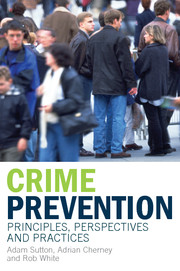7 - Prevention in public places
from PART 2 - PRACTICE
Summary
Introduction
This chapter will discuss the following topics:
the notion of community is constructed around where we live and shop;
involving youth in crime prevention;
crime prevention and community spaces: planning, management and social development; and
shopping centres and people-friendly environments.
The aim of this chapter is to discuss crime prevention in relation to the use of public spaces. More specifically, the chapter is premised on the fact that very often the notion of community, and of community safety, is constructed around where we live, shop and engage in leisure pursuits. Perceptions of safety in our residential areas and local neighbourhoods, and how security is provided for in shopping centres and shopping strips, have a concrete and immediate bearing on how people experience their everyday lives.
When we speak of community crime prevention and community organisations it is essential to bear in mind that ‘community’ incorporates many different interests, groups, struggles, agendas, strategies and relationships to the state (Carson 2004a, 2004b; White and Perrone 2005; Hughes 2007). This has to be taken into account when considering specific crime prevention measures.
Communities can initially be delineated by territorial boundaries. These may include:
geography (local, regional or international): people living in the same area;
power structures (Federal, state, local government): defined by electoral boundaries; and
services (transport line, school): defined by service providers such as local councils.
The essential link here is one of locality – a collective identity is shared simply due to the physical fact of where you live.
- Type
- Chapter
- Information
- Crime PreventionPrinciples, Perspectives and Practices, pp. 114 - 134Publisher: Cambridge University PressPrint publication year: 2008



